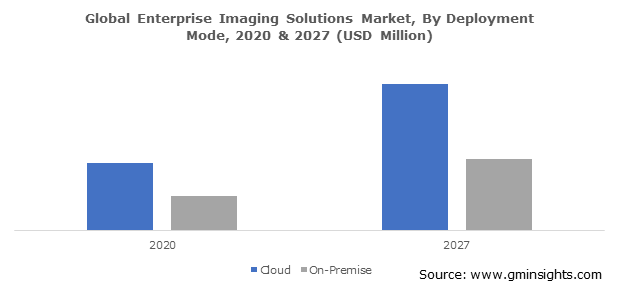Enterprise Imaging Solutions Market worth over $2.2bn by 2027
Published Date: March 2021
Enterprise Imaging Solutions Market size is set to surpass USD 2.2 billion by 2027, according to a new research report by Global Market Insights Inc.
The consistent increase in the number of chronic disease cases globally, coupled with rise in geriatric population and growing awareness of consumers about precautionary health measures are some of the factors driving the market growth. High adoption of cloud-based solutions allows the physicians and clinicians to have remote access to patient's imaging data irrespective of location is impelling the market expansion. The rising acceptance of advanced imaging modalities around the world has resulted in augmenting the demand for enterprise imaging solutions. Furthermore, speeding up the diagnosis process, affordability, improved EHR integration are some of the other benefits offered by enterprise imaging solutions.
Consistent rise in cloud-based solution deployments will foster the enterprise imaging solutions market value
The importance of healthcare IT is truly recognized by the players operating in the global healthcare market as majority of the product offering is based on cloud deployment. The growing usage of digital solutions, increasing deployment of cloud-based solutions especially related to enterprise imaging are influencing the market revenue. In the cloud-based PACS solution, patient's data and digital images are stored automatically in the cloud at the time of their creation that allows users to access the data easily.
Cloud-based product deployment allows both the caregiver and caretaker to get all the necessary information on a single platform. This benefits the patients to remain updated with their treatment status, receiving reports, appointment or rescheduling, and other help desk activities. According to a survey by the HIMSS Analytics, more than 83% of healthcare organizations have already incorporated cloud-based services in some form or other. Additionally, the increasing adoption of VNA is indirectly fueling the cloud-based solutions in the market. Other supportive factors that are playing a crucial role in increased deployment of cloud-based solutions are improved IT security, scalability, lowered cost structure and wide acceptability of enterprise imaging solutions across all end-users in healthcare sector.
Growing acceptance for cloud-based deployment will boost the enterprise imaging solutions market demand

Get more details on this report - Request Free Sample PDF
The cloud segment accounted for more than USD 704 million in 2020 owing to reduced IT costs, improved security, single service supplier, and reduced downtime. Scalability, improved innovation and notable reduction in regulatory compliance related work for the vendor are other factors that are propelling the cloud-based enterprise imaging solution deployment.
Browse key industry insights spread across 150 pages with 154 market data tables & 16 figures & charts from the report, “Enterprise Imaging Solutions Market Size By Deployment Mode (Cloud, On-Premise), By Solution Type (Vendor Neutral Archive (VNA), Picture Archiving and Communication System (PACS), Image Exchange, Universal Viewer), By End-user (Hospitals, Diagnostic Imaging Centers), Industry Analysis Report, Regional Outlook, Application Potential, Competitive Market Share & Forecast, 2021 – 2027” in detail along with the table of contents: https://www.gminsights.com/industry-analysis/enterprise-imaging-solutions-market
Increasing preference for VNA implementation will spur the industry growth
The enterprise imaging solutions market for VNA segment is anticipated to witness 15.2% growth rate till 2027. One of the basic and primary function of VNAs is that they enable the acquisition, storage and management of images while streamlining the internal communication between multiple PACS systems. The vendor neutral archives can capture both DICOM and non-DICOM content and it can fully integrate with existing clinical systems thus providing a complete 360° access of all patient data. Additional features such as reduction in storage costs, better support for disaster recovery, and significant decline in unscheduled outages are contributing in the increased deployment of enterprise imaging solutions.
Rise in installation of enterprise imaging solutions in hospitals will impel the market expansion
The hospital end-use in the enterprise imaging solutions market valued at USD 752 million in 2020. As hospitals cater to large number of patients from across departments, there are numerous initiatives undertaken to implement advanced technologies in order to provide better patient-centric care. In addition, increasing geriatric population that needs imaging services at regular intervals coupled with the need to store, retrieve and access that data will create lucrative market growth opportunities.
Growing digitization in Germany is projected to drive the regional growth
Germany enterprise imaging solutions market size was more than USD 61 million in 2020 led by increasing trend of digitization in imaging. The country is also observing replacement of older generation methods with the new modern equipment, thereby improving the efficiency and quality of imaging services provided to patients. German healthcare providers are strongly emphasizing on using a standard, interoperable format such as DICOM.
Key players are adopting several business strategies to capture significant market share
Some of the major companies operating in the market include IBM Corporation, Siemens Healthineers, FUJIFILM Medical Systems U.S.A., Inc., GE Healthcare, Koninklijke Philips N.V., and Agfa-Gevaert among others. Market leaders are adopting various strategies to capture major portion of the industry pie. Partnering with other leading participants to enhance company's product offerings and providing updates to existing solutions are among the primary strategies adopted by the players.





